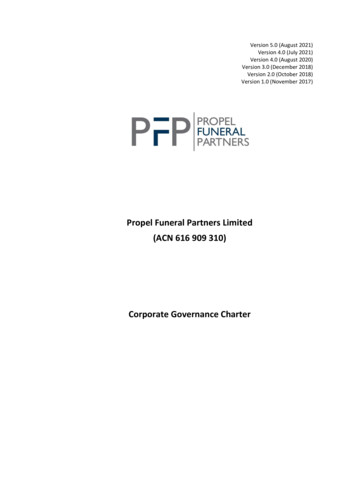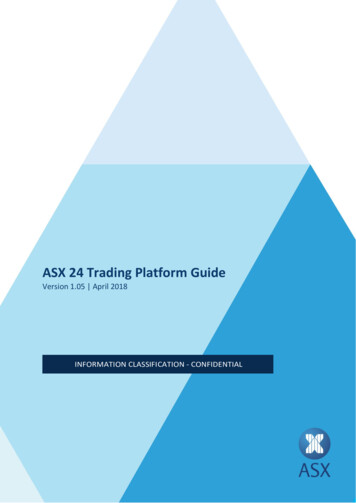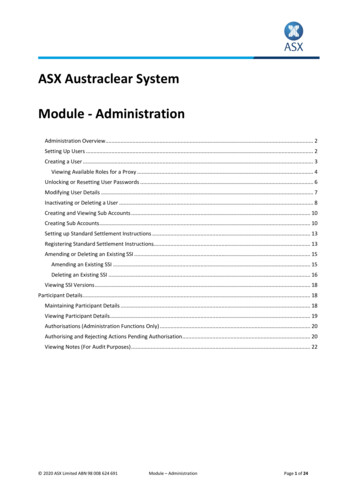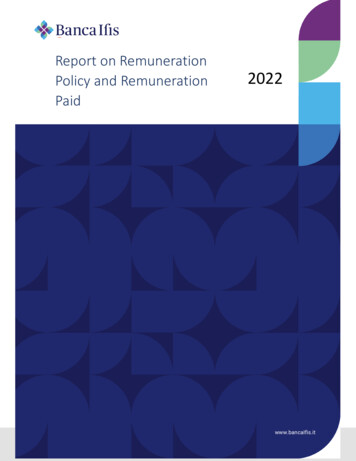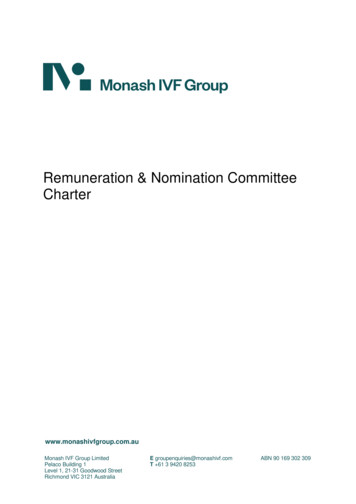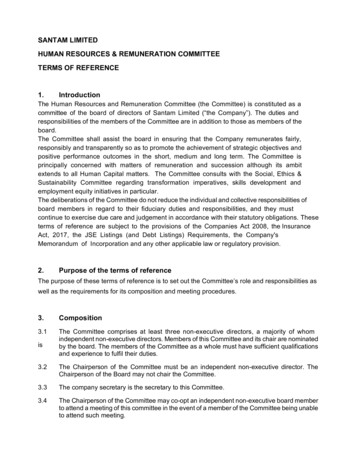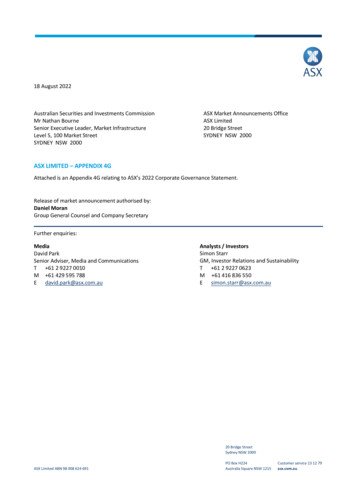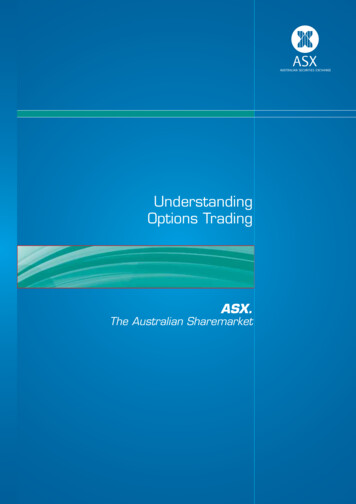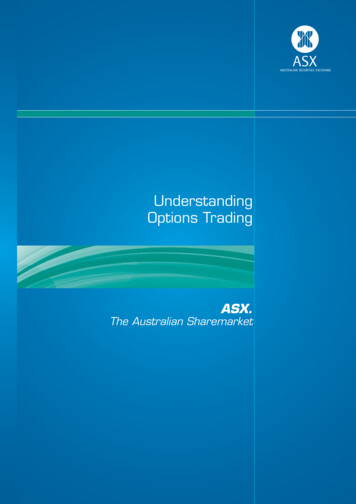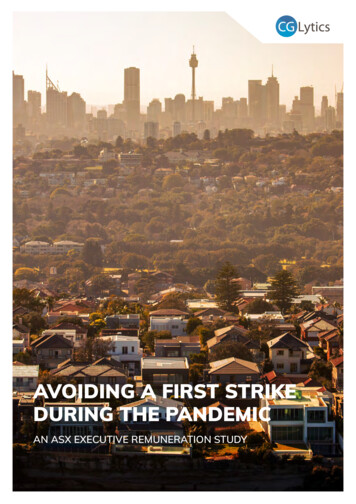
Transcription
AVOIDING A FIRST STRIKEDURING THE PANDEMICAN ASX EXECUTIVE REMUNERATION STUDY
About CGLyticsCGLytics is transforming the way corporate governancedecisions are made, for effective oversight andcompetitive edge. Combining the broadest governanceand executive remuneration data set in the market tions to make better informed, data- drivendecisions.CGLytics provides real-time data for an independentanalysis of companies’ governance practices includingpeer benchmarking. CGLytics is the source of globalremuneration data and analytics for Glass Lewis’svoting recommendations and is a trusted Diligentpartner.Utilise the range of CGLytics tools tobenchmark your governance practicesagainst 5,900 global companies and befully prepared for proxy season:Executive Compensation BenchmarkingGlass Lewis Compensation AnalysisGlass Lewis Equity Compensation Model (ECM)Corporate Governance BenchmarkingBusiness Relationship MappingContact CGLyticsAVOIDING A FIRST STRIKE DURING THE PANDEMIC AN ASX EXECUTIVE REMUNERATION STUDY—
About the StudyExecutive remuneration is an important aspect ofcorporate governance, as it serves as an indication ofthe alignment between executive pay policies andshareholder interests. This paper aims to analyse thechanges in executive remuneration in light of theCOVID-19 pandemic, as well as various trends in CEOpay components and performance metrics.Executive remuneration has always been a focal pointfor shareholders, specifically the issues regardingremuneration policies and outcomes. Shareholders andproxy advisory firms have been focusing on themeasurability and clarity of non-financial metrics,pushing for longer vesting periods, and the inclusion e metrics in executive remuneration plans.Data and insights from CGLytics provide a currentoverview of the pay for performance landscape of boththe ASX 300 and ASX 100. The report providesstakeholders a better understanding of the relativepositioning of CEO total realised pay against totalshareholder return (TSR) over one- and three-yearperiods.This report reveals the executive remuneration practicesof Australian companies, and highlights stakeholdersentiments, to help understand the upcoming corporategovernance trends in the Australian market for the 2020proxy season.AVOIDING A FIRST STRIKE DURING THE PANDEMIC AN ASX EXECUTIVE REMUNERATION STUDY—
ContentsAbout CGLytics—About the Study—COVID-19 and the Impact on Remuneration03CEO Remuneration Reduction amidst COVID-1904CEO Pay Cut Components04CEO Base Salary Reduction Only a Small Price to Pay04Pay Adjustments by Industry05Company Pay Cuts Do Not Reflect Well05Executive Pay Landscape in Australia06Highest Paid CEOs in 201906Evolution in Pay Components06AGM “Strike” Highlight07CEO Pay for Performance Review08CEO Three-Year Pay for Performance Positioning (ASX 100)09CEO Three-Year Pay for Performance Positioning (Finance Industry)10Projected CEO Pay for Performance Alignment after COVID-19 Adjustments11Predictions for the Australian Remuneration Landscape in 2020 and Beyond12References13AVOIDING A FIRST STRIKE DURING THE PANDEMIC AN ASX EXECUTIVE REMUNERATION STUDY
COVID-19 and the Impacton Remuneration61 ASX 300 companies reduced directorand/or CEO remuneration.61 ASX 300 Companies: Breakdownof Pay Cuts by Position60 out of the 61 companies reduced CEO pay.8%2%Qantas Airways reduced board and executivepay1, forfeited CEO and Chair salaries.Myer CEO voluntarilyremuneration2.suspendedhisThe COVID-19 pandemic has had a severe negativeimpact on the global market. Australia is no exception,with nearly one million Australians losing their jobs.Amidst the crisis, various companies called on theirboard of directors to develop and implement crisismanagement strategies to maintain cash positions andensure the health and well-being of their employees3.Some companies have taken drastic measures bystanding down employees or reducing executive,director, and employee remuneration to maintainliquidity.61 of ASX 300 companies reported the lowering ofdirector and/or Chief Executive Officer (CEO)remuneration from March 2020 until the first week ofAugust 2020. Out of the 61 companies, five companiesmodified remuneration for just the CEO, one for just thedirectors (chairman and directors excluding CEO), and55 for both the CEO and directors. In total, 60 companiesinitiated pay cuts for their CEOs, and 56 companiesannounced pay cuts for their directors.Out of the 60 companies that initiated CEO pay cuts, 54of those companies provided a percentage of payreduction while the other six did not disclose the specificpercentage. In addition, 49 out of the 56 companies thatinitiated director fee cuts disclosed its percentage of payreduction, while seven companies did not.90%CEO and Board of DirectorsCEO OnlyDirectors (Excluding CEO)Source: CGLytics Data and Analytics61 ASX 300 Companies: Pay Cuts 2%80%CEODisclosedAVOIDING A FIRST STRIKE DURING THE PANDEMIC AN ASX EXECUTIVE REMUNERATION STUDYBoard of DirectorsUndisclosedSource: CGLytics Data and Analytics03
CEO Remuneration Reductionamidst COVID-19CEO Pay Cut ComponentsAmong the 54 companies that initiated CEO pay cutsand disclosed the pay cut percentages, 35 companiesreduced CEO base salaries, 17 companies reduced boththe base salary and cash bonuses, and two companiescut only the cash bonus.Components of CEO Pay CutHowever, the company received support from itsshareholders as they helped raise AUD 1.2 billionthrough 8 institutional placement8.CEO Base Salary Reduction Only a Small Price to PayOf the companies that reported CEO base salaryadjustments, 26 companies cut the salary by 10-20%,which resulted in an average cut of only 9.23% of theaverage CEO realised pay in 2019. 22 companiesinitiated pay cuts of 20-50% for an average cut of11.91% of the average CEO realised pay in 2019.Interestingly, of the four companies that reduced CEOpay by 70% or more, the average cut was only12.11% of average CEO realised pay in 2019.31%65%Portion of CEO Base Salary Reduction8%4%Base Salary OnlySTI OnlyBase Salary and STISource: CGLytics Data and Analytics50%42%Nearly all companies initiated pay cuts only to their CEObase salary. However, 17 companies not only reducedtheir CEO salaries, but also reported a foregoing of theirshort-term incentives, two of them being Flight Centreand Vicinity Centres.Flight Centre, one of Australia’s largest travel agencies,announced a 50% pay cut for senior executives anddirectors until at least the end of FY20. The CEO andexecutives of Flight Centre will also relinquish allshort-term incentive components of their remunerationfor the full financial year 20204. Despite announcing astrong balance sheet of AUD 1.3 billion in cash, thecompany announced the permanent closure of 428stores and a request for AUD 900 million in financing5. 10%- 20% 20%- 50% 70Source: CGLytics Data and AnalyticsOne of Australia’s leading retail property groups, VicinityCentres, announced not only a 20% cut of executivesalaries, but also a cancellation of their FY20 short-termincentives6. The effects of the pandemic on the companywere still detrimental, lowering the company’s propertyvalues significantly7.AVOIDING A FIRST STRIKE DURING THE PANDEMIC AN ASX EXECUTIVE REMUNERATION STUDY04
Pay Adjustmentsby IndustryThe third largest sector is the Industrial sector, whichincludes airlines, transportation, capital goods, andcommercial and professional services industries.61 ASX 300 Companies: PayAdjustments By Sector3%3%3%26%8%11%20%FinancialConsumer DiscretionaryIndustrials25%Communication ServicesHealth CareConsumer StaplesEnergyMaterialsSource: CGLytics Data and AnalyticsAmong the 61 ASX 300 companies that reported paycuts from March to the first week of August 2020, thelargest portion (26%) came from the Financial sector,which includes real estate, capital markets, diversifiedfinancials, banks, and insurance companies. 25% of thecompanies with pay adjustments are from the ConsumerDiscretionary sector, which includes automobiles,consumer durables and apparel, consumer services andthe retail industries.While the repercussions of the COVID-19 pandemicaffected many different industries, the airline sectorarguably suffered the most. Airline giant QantasAirways released a statement revealing its intention tocut costs and maintain liquidity for the next six months.The airline company stood down over 25,000employees and secured AUD 550 million in debtfunding9. Qantas CEO, Alan Joyce, and Chairman,Richard Goyder, have forgone their full salaries for thefinancial year, with board members and groupexecutives taking a 30% cut in remuneration10.Although the Australian government has beguneasing some restrictions, the resumption ofinternational and domestic air travel remainsuncertain11.The retail industry has also taken a significant hit, withmore than 40,000 retail workers stood down12. One ofAustralia’s largest retail stores, Myer, stood down10,000 store and store support staff in early March2020. Myer’s CEO and Managing Director John Kingand the executive team have voluntarily suspendedtheir remuneration during this difficult period13.Despite the closure of its brick-and-mortar stores,Myer has seen a substantial increase in online sales,which has allowed for the return of 20% of stood downemployees14.Company Pay CutsDo Not Reflect WellPay cuts represents only 1.29% of ASX 100projected CEOs realised remuneration for thefinancial year 2020.For the ASX 300, pay cuts and or adjustmentsis estimated to represent only 2% of CEOrealised remuneration.CGLytics data and analysis reveals that the combinedCEO pay cuts initiated by the 54 companies in the ASX300 is anticipated to account for 11.34% of the 54companies’ combined projected CEO realised pay.Despite the appeal of executive pay cuts, they makeup a small portion of what executives receivethroughout the year. A well-meaning but insignificantpercentage of executive pay cuts against their totalremuneration can cause concern for shareholders,especially for companies that have resorted to layingoff employees and closing stores.AVOIDING A FIRST STRIKE DURING THE PANDEMIC AN ASX EXECUTIVE REMUNERATION STUDY05
Executive Pay Landscapein AustraliaCGLytics has reviewed the ASX 300 CEOs’ total realisedpay during the 2019 proxy season from annual reportdisclosures. The analysis sheds light on the top fivehighest paid CEOs based on their total realised pay,which is calculated as the total of total fixedremuneration, realised short-term incentives andrealised long-term incentives.IDP Education CEO Mr. Andrew Barkla received3.4 million options from a 2016 sign-on bonus, 15vested in 2019 15.CSL Limited CEO Mr. Paul Perreault’s total realisedpay increased by more than 300% from 2018to 2019.ResMed Inc. CEO Mr. Michael Farrell’s 2019 totalrealised remuneration increased by 6% from 16201816.Highest Paid CEOs in 2019IDP Education LimitedAUD 52 millionCSL LimitedAUD 38 millionResMed Inc.AUD 29.5 millionEmeco Holdings LimitedAUD 26.3 millionMacquarie Group LimitedAUD 26.2 millionEmeco Holdings CEO Mr. Ian Testrow’s basesalary increased by 12% from 2018 to 2019.MacquarieGroupWikramanayake isfemale CEO17.CEOMs.ShemaraAustralia’s highest-paidEvolution in Pay ComponentsLTIs are theremuneration.largestcomponentofShareholders have been challenging boards to createCEO remuneration mixes that incorporate long-termincentives (LTI) as the largest component of executiveremuneration18. CGLytics data suggests that LTIs formthe largest component of an ASX 300 CEO’s totalremuneration, revealing an increase of 8.4% from2017 to 2019. Furthermore, the short-term incentive(STI) component has faced a decline of 5.3% from2017 to 2019. The base salary portion had noincrease from 2017 to 2019.CEO2019 had an LTI to STI ratio of 2.28, an 8.4%increase from 2017.Average CEO Realised Pay BreakdownBase 1947%60%40%20%20%0%Source: CGLytics Data and AnalyticsAVOIDING A FIRST STRIKE DURING THE PANDEMIC AN ASX EXECUTIVE REMUNERATION STUDY06
AGM “Strike”Highlight24 companies received a strike in 2019compared to 20 in 2018.Ramsay Health Care received a strike due tounclear and excessive STI outcomes.Proxy advisory firm Glass Lewis reported that there hasbeen a trend of an increasing number of “strikes” againstthe adoption of remuneration reports, with 24 strikes in2019 compared to 20 in 2018. Reasons for eunreasonably high STI outcomes and unclear groundtargets for performance measures.Ramsay Health Care dodged a first-strike against theadoption of its remuneration report during its 2018Annual General Meeting (AGM), with a 24.88% vote outof the 25% required for a first strike19. Chairman MichaelSiddle was “disappointed” by the shareholder decisionas he believed that executives were not paid excessively.However, Mr. Siddle agreed to review the company’sremuneration policies by receiving advice from bothshareholders and proxy advisors for the upcoming yearin 2019.Mr. Rod McGeoch, the current chair of theremuneration committee, stated that the company putmuch effort into integrating KPMG’s recommendationsinto Ramsay Health Care’s remuneration policies. Mr.McGeoch also announced that the company wouldtake into consideration non-core items such asrestructuring and lease expenses when measuringearnings per share outcomes24. Mr. Siddle hasacknowledged that the manipulation of core/non-coreitems is a risk, and will review such considerationsagain for the company’s 2020 remuneration report.CGLytics offers executive remunerationbenchmarking tools that are currentlyused by institutional investors, activistinvestors and leading proxy advisor GlassLewis for recommendations in their proxypapers.Learn MoreUnfortunately, Ramsay Health Care was one of the 24companies that acquired a first strike against theadoption of its remuneration report during its 2019 AGM.29.23% of its shareholders voted against the reportdespite the board members having reframed the reportfor the 2019 financial year20. The board introduced asimplified STI scorecard dubbed the “Ramsay Way”which outlined five key performance metrics: financialperformance, global strategy execution, people,consumer, and quality21. Shareholders rejected thereport on grounds that the five performance metricswere vague and difficult to measure22. Furthermore,despite having extended the STI deferrals for executives,the company still paid out almost the entire STI amountavailable for the financial year23.AVOIDING A FIRST STRIKE DURING THE PANDEMIC AN ASX EXECUTIVE REMUNERATION STUDY07
CEO Pay forPerformance ReviewThree-year Pay for Performance ReviewThe CGLytics Pay for Performance software tool showsthe relative positioning of both ASX 300 and ASX 100companies from 2017 to 2019 and compares the CEO’sthree-year total realised pay against the company’sthree-year Total Shareholder Return (TSR).ASX 30029% of companies have a conservative paypractice, wherein the CEO total realised pay isrelatively lower than that of the company TSR.35% of ASX 300 companies have an aligned relativepositioning over three years.36% of companies have a misaligned pay practice,wherein the CEO total realised pay is relatively higherthan the company TSR (performance).ASX 300: Pay for Performance Alignment (2017 - rvativeSource: CGLytics Data and AnalyticsASX 10036% of ASX 100 companies have an aligned paypractice over three years.29% of companies have a conservative paypractice.35% of companies have a misaligned pay practice.-ASX 100: Pay for Performance Alignment (2017 - lignedConservativeSource: CGLytics Data and AnalyticsAVOIDING A FIRST STRIKE DURING THE PANDEMIC AN ASX EXECUTIVE REMUNERATION STUDY08
CEO Three-Year Pay for PerformancePositioning (ASX 100)50th0th3 YR Sum Total Realised pay - percentile ranking100th2017 - 2019 Pay for Performance alignment (ASX 100)CEO Total realised pay vs TSRMacquarieBlueScope SteelCSLResMedTreasury WineRamsay Health CareEnterprisesQantas AirwaysGoodman a2 MilkSonic Healthcare EstatesAmcorSEEKChallengerNewcrestMiningAGL EnergyWoodside PetroleumRio Tinto LimitedScentreOroraWoolworths Evolution MiningWesfarmersSantosQBE Insurance LendLeaseSouth32BoralOil SearchBHP BillitonCrown ResortsBramblesAristocrat LeisureCommonwealth Bank Dexus APASuncorp of AustraliaInsurance AustraliaWhitehaven CoalTransurbanCaltex AustraliaCleanaway WasteCharter HallDowner EDITelstraFortescue MetalsNational AustraliaManagementAnsellQubeWestpac Banking BankCoca-ColaAmatilSydneyAirportCYBGAustralia and NewGPTMirvac CochlearZealand BankingMagellan FinancialOricaTabcorpStar EntertainmentAurizonComputershareWorleyIncitec PivotMedibank PrivateJB Hi-FiAMPStockland Origin EnergyREANIBBank of QueenslandReliance Worldwide ALSAusNetServicesOZMineralsVicinity CentresBeach EnergyASXIluka Resources AluminaAltiumBendigo and TPG Telecomcarsales.comNine EntertainmentSpark InfrastructureWashington H. SoulNorthern StarAdelaide BankResourcesPattinsonCIMICAtlas ArteriaWisetech GlobalLink AdministrationXeroFlight Centre TravelJames HardieIndustriesDomino's Pizza0th50th100thPerformance indicator TSR - percentile rankingCGLytics analysis reveals Downer EDI is thebest-aligned company on the ASX 100 as of 2019,positioned in the 56th percentile ranking for both CEOtotal realised remuneration and company TSRperformance. Shareholders showed strong support forthe 2019 remuneration report, receiving 97%approval25. One of the highlights indicate that thecompany’s TSR, an LTI performance metric of theremuneration policy is 85.2% higher compared to that ofthe ASX 100 median comparator group. As a result,Downer EDI vested 100% of its LTI awards26 .Source: CGLytics Data and AnalyticsSonic HealthcareOne company that displayed misalignment is SonicHealthcare Limited. The healthcare firm is in the 88thpercentile of CEO remuneration but only in the 53rdpercentile of company TSR performance. SonicHealthcare also received a first strike after a 25.56%vote against the adoption of its remuneration reportduring its 2019 AGM27. Glass Lewis stated that thehealthcare company awarded above target STIbonuses because of its high EBITDA growth. Despitethe policy to exclude acquisitions from EBITDA growth,the company included the acquisition as a part of theirdecision to pay out STI bonuses. The company wouldnot have met the STI bonus targets if they hadadhered to company policy.AVOIDING A FIRST STRIKE DURING THE PANDEMIC AN ASX EXECUTIVE REMUNERATION STUDY09
CEO Three-year Pay for PerformancePositioning (Finance Industry)Relative position of Westpac Banking Corporation within the Finance Industry Peer Group (2019)CEO Total realised pay (3Y) - Percentile rank100Macquarie Group LimitedChallenger LimitedQBE Insurance Group LimitedCommonwealth Bank of AustraliaSuncorp Group LimitedInsurance Australia Group LimitedWestpac Banking CorporationAustralia and New Zealand Baning Group Limited50National Australian Bank LimitedMagellan Financial Group LiMedibank Private LimitedAMP LimitedNIB Holdings LimitedBank of Queensland LimitedASX Limited0Bendigo and Adelaide Bank Limited050100Total shareholder return (3Y) - Percentile rankWestpacAfter the Royal Commission into misconduct in thebanking, superannuation, and financial servicesindustry, CGLytics analysed the pay for performancepositioning of Westpac against the finance industrywithin the ASX 100 over three years. The most alignedbank is the National Australia Bank, where its CEO’stotal realised pay is in the 47th percentile and companyTSR performance is in the 40th percentile.Source: CGLytics Data and AnalyticsWestpac Banking Corporation reveals pay forperformance misalignment, with CEO remuneration inthe 60th percentile while company TSR is in the 20thpercentile. Westpac faced several class actions,scandals, and scrutiny from the Australian TransactionReports and Analysis Centre (AUSTRAC) in 201928.Westpac’s CEO did not receive an STI bonus, and evenforfeited his 2016 LTI award29. This did not stopshareholders from going against the adoption of thecompany’s remuneration report, recording asecond-strike during the 2019 AGM30.AVOIDING A FIRST STRIKE DURING THE PANDEMIC AN ASX EXECUTIVE REMUNERATION STUDY10
Projected CEO Pay for PerformanceAlignment after COVID-19 AdjustmentsASX 300CGLytics has compared the 2019 pay for performance ofASX 300 companies against the projected 2020 relativepositioning (again using CEO total realised pay againstTSR). The FY20 figures used in the study is the totalrealised pay after the COVID-19 pay cuts and comparedagainst the companies’ year-to-date TSR.It is revealed that there is an 21% increase ofcompanies that show an alignment in FY20. Anincrease in aligned companies with the totalshareholder return could be a consequence of the paycuts made during the year. The analysis also reveals a16% decrease of companies that are misaligned.Conservative pay practice remains unchanged.ASX 300: Changes to Alignment in gnedMisalignedConservativeSource: CGLytics Data and AnalyticsASX 100CGLytics has completed the same CEO pay forperformance projection for ASX 100 companiesfollowing pay reductions for FY20, utilising year-to-dateTSR.The analysis reveals a 13% increase of companiesshowing alignment in FY20 and a 3% decrease ofmisaligned companies, potentially due to the pay cuts.Lastly, there is a 13% decrease in conservative paypractice.ASX 100: Changes to Alignment in gnedMisalignedConservativeSource: CGLytics Data and AnalyticsAVOIDING A FIRST STRIKE DURING THE PANDEMIC AN ASX EXECUTIVE REMUNERATION STUDY11
Predictions for the AustralianRemuneration Landscapein 2020 and BeyondAustralia Called to Disclose CEO Pay RatioAustralia’s top CEOs are paid 78 times more than theaverage employee31.Major markets recently updated their reportingrequirements on executive remuneration. In January2019, the House of Commons Business, Energy andIndustrial Strategy Committee in the UK introduced therequirement for public companies with more than 250employees to disclose the ratio of CEO to employeepay32. Companies must annually disclose the ratio of theCEO pay to the median, lower quartile, and upperquartile remuneration of their employees based in theUK33.Shareholders voiced the need for listed companies todisclose the ratio of their CEO to average employee payto ensure transparency34. Recent reports show that therate of pay increase of ASX 100 CEOs was more thanfour times that of an average worker35.This could lead Australian stakeholders to show concernregarding the disproportionate income between CEOsand average workers and urge regulators to implementrequirements similar to that of the UK.Change in Incentive and Performance MeasuresExecutive remuneration has always been an area ofinterest for regulators, proxy advisory firms andshareholders, especially when efforts are made to alignremuneration structures with long-term objectives. ASX300 companies have shown a gradual shift inremuneration policies, with the composite LTI/STI ratio at2.28 in 2019 compared to 1.94 in 2017. Furthermore, LTIawards assist in retaining executives. A surveycompleted by the Australian Human Resources Institute(AHRI) presented data indicating Australian companiesspend an additional AUD 20 billion per year due to staffturnover.According to the Australian Institute of CompanyDirectors (AICD), shareholders are in favor ofextending performance periods for LTIs36.Investors are looking at the connection between CEOpay and a company’s overall performance. Board ofdirectors are slowly integrating non-financial metricsinto CEO remuneration, with company culture andEnvironmental, Social and Governance (ESG) factorscounting towards CEO performance37.A recent study on the FTSE 350 shows that companiesthat combine both financial and non-financialmeasures in CEO incentives better align CEO bonuseswith shareholder interests38.A 2017 study completed by the ResponsibleInvestment Association Australia (RSIAA) showedthat assets managed under an ESG reached AUD866 Billion, up 37% from 201639.Addressing Social IssuesShareholders and other stakeholders previouslycriticised companies mainly on their financialoutcomes. However, the increasing demand foraccountability and corporate social responsibility isforcing companies to address issues that go beyondtheir everyday operations. Companies must nowaddress a range of issues such as climate change,gender diversity on boards, and ethnic diversityespecially in light of the Black Lives Matter movement.According to a 2016 AICD report, there are noindigenous CEOs in Australia and 75% of CEOs areof white ethnicity. Out of the 2,500 executives thatparticipated in the survey, 97% are white40.In May 2020, Rio Tinto’s demolition of ancient rockshelters revered by the Australian Indigenouscommunity sparked outrage from the media andstakeholders41. The company has since issued anapology and has begun working closely withIndigenous leaders to regain its trust with the groupsmost affected42. This incident has been a driver formore representation and power given to Indigenouspeople43.Moreover, the media and stakeholders are concernedthat there is not enough ethnic diversity in theAustralian corporate environment. Statistics indicatethat 93% of CEOs and 70% of board members are allfrom an Anglo-Celtic heritage44 in Australia. One ofthe solutions considered is another implementation ofquotas and targets to force boards to include andrepresent minorities in corporate Australia45.CGLytics offers the broadest and deepest globalcompensation data set for reviewing corporateexecutive remuneration plans, assessing Say on Payvote proposals and performing benchmarkinganalysis.Contact CGLyticsAVOIDING A FIRST STRIKE DURING THE PANDEMIC AN ASX EXECUTIVE REMUNERATION STUDY12
ge-2A1212226?access token ?nw 0#: :text %20the%20average%20Australian%20worker.&text ansparency-measures-come-intoforce#: :text 215961?access token 3A540747?access token in-test-case-20200518- A1212226?access token -destruction-20200612- ff- ite-prompts-heritage- ral-australias-mostly-white-corporate- 67583fffa/2019.pdf?v /multicultural-australias-mostly-white-corporate- boardrooms/1032979416 aid-ceo-australianew-worth-2019-1118 ts-love-child-board-nominee-as-it-dodges
Executive remuneration is an important aspect of corporate governance, as it serves as an indication of the alignment between executive pay policies and shareholder interests. This paper aims to analyse the changes in executive remuneration in light of the COVID-19 pandemic, as well as various trends in CEO pay components and performance metrics.
